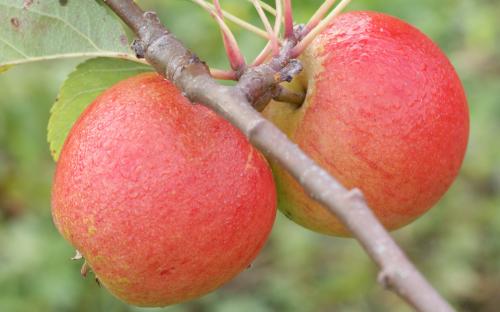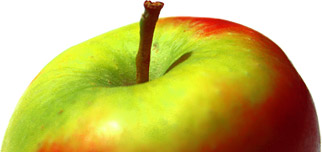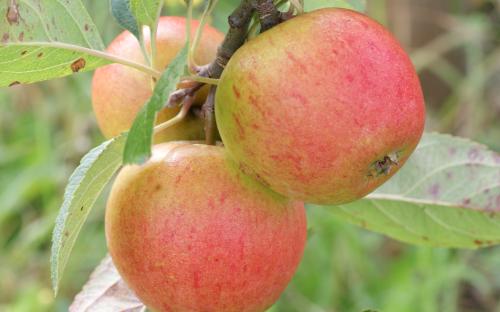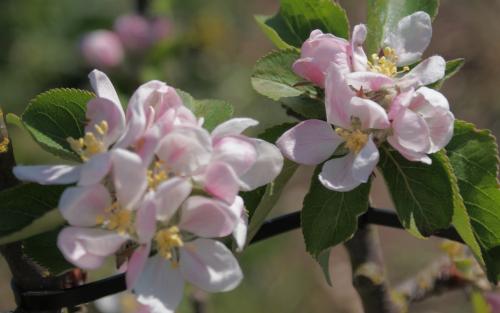
Lord Lambourne was introduced in 1907 and is very much in the tradition of classic English high-quality dessert apples. It has the pleasing uniform shape - round, and not too flattened - and typical orange flush over green, with a hint of russet. On biting into a Lord Lambourne the first thing that strikes you is the juice and acidity. The flesh is creamy-white and quite crisp, and the flavour is pleasantly strong.
It is a fair bet that such a high-quality aromatic apple will have Cox's Orange Pippin somewhere in its ancestry but the link is not certain. The immediate parentage is James Grieve and Worcester Pearmain, and the parentage of James Grieve is not known although Cox is a contender. If so, then the aromatic flavour of Cox is rather more apparent in Lord Lambourne than in James Grieve, although the James Grieve acidity is still prominent.
Lord Lambourne has two siblings which share the same parentage - Katy and Elton Beauty. However Lord Lambourne is the odd one out of the three, since Katy and Elton Beauty both have the sharp zing of James Grieve and the up-front summery strawberry flavours of Worcester Pearmain. Lord Lambourne offers quite a different taste experience, with more depth and subtlety.
Another interesting comparison is with Topaz, a very modern variety and distantly related to Lord Lambourne. Topaz arrives much later in the season but like Lord Lambourne it has some of the classic English aromatic flavour, overlaid with plenty of juicy acidity. Despite being developed nearly a century apart, both these varieties are (arguably) much better apples than their common ancestor James Grieve.
Like many of the James Grieve offspring, Lord Lambourne is an easy apple variety to grow in the garden, and produces good crops. It is also (like Katy) fairly easy to find in the UK at farmers markets, and occasionally in supermarkets.
Lord Lambourne is, along with Ellisons Orange, one of the earliest of the aromatic English-style apples, and whilst it does not have the complexity of the later-arriving varieties it is nonetheless a pleasing apple in its own right.
Lord Lambourne apple identification images
All images copyright Orange Pippin unless otherwise stated.
USDA identification images for Lord Lambourne
The identification paintings in the USDA Pomological Watercolor Collection span the years 1886 to 1942.
Citation: U.S. Department of Agriculture Pomological Watercolor Collection. Rare and Special Collections, National Agricultural Library, Beltsville, MD 20705.
Parents and other ancestors of this variety
- James Grieve (parent)
- Worcester Pearmain (parent)
Siblings of this variety (same parentage)
Visitor reviews
- 12 Sep 2023I noted in my own records, several years ago, that this apple is "reminiscent of watermelon". This year it is even more so - sweet and juicy, but very little flavour.
- 05 Oct 2016 WASHINGTON, United StatesLove this apple - it just can't deal with arid conditions well. Must strip it of fruit in order for the li'l tree to grow, which I finally did this season. I must find a friend or family member on the soggy side of Washington state to give it to, so I can still enjoy it some years. Great apple; prodigious blooming and easy-care tree, but for the cracked fruit.
- 13 Sep 2015 WASHINGTON, United StatesThis has been a record hot and dry summer. The LL apple on the sunny side of the tree took a beating, two large cracks. Yesterday (Sept. 11) I picked it and checked for sugar level: 29 Brix! I checked twice more to be sure. Quite dry due to the cracks, in contrast to last year, and with surprising complexity. The other apples are fine despite the weather.
- 13 May 2015 WASHINGTON, United StatesThis one generates comments, huh? I had the first taste of LL last fall, just three apples on a midget tree. Decided it will never be big enough standing on Bud9, so dug it up and re-planted it by burying the graft union. It should grow to be a compact standard and yield a crop worth waiting for!
- 01 May 2015 NSW, AustraliaGreat tasting apple. Very similar to Cox's Orange Pippin but earlier by about 3 weeks. Highly recommended. I grow it in Katoomba, NSW, Australia.
- 15 Nov 2014 MARKET RASEN, United KingdomMy favourite Apple ever,you may remember quarkhill fruit farm back along I was born and brought up there and came to yours on occasion with my dad(les gill) this has always been our family's favourite
- 17 Sep 2014 LONDON, United KingdomPicked mine off a small tree at Wisley and was blown away by the taste - slightly acidic, but a lovely background sweetness too. Crispy and crunchy too. Nice skin. Perfect for kids as not too enormous. When I have a large garden in my next dream home, I'll be planting some Lord Lambournes, I think.
- 27 Mar 2014 VIC, AustraliaI have this in Mt Macedon, Victoria, Australia. Great variety. Good yearly cropper, not too acidic. keeps better once picked than Cox's. Great smaller apple for kids to eat. One of my top varieties. if I only had room for say 3 trees, this would be one of them.
- 10 Nov 2012 WASHINGTON, United StatesAbout a month after my last note on this apple, flower buds appeared on the one-year-old LL! Definitely a partial tip bearer; so pinched 'em off after the bloom and it has grown to about 3 feet tall. Have since seen two references implicating fungicides exacerbating cracks in apples. Since I keep leaf litter cleaned up, this should be a minor issue.
- 10 Sep 2012 KENT, United KingdomI have a Lord Lambourne apple tree with about a ton of apples - are they any good for cider making?
- 05 Mar 2012 WASHINGTON, United StatesBought a bench graft from Greenmantle in CA last year - on Bud9. Li'l guy is doing fine. Am a bit concerned about the comment from CA about dryness and cracking. My climate is rather hot and dry in late summer. Still hopeful.
- 12 Oct 2011 BC, CanadaNever even heard of this apple until my brother introduced me to it. They grow it at his work for testing, and the excess goes to staff and their families. I love both Granny Smith, and Fuji, but I have now found my favorite! Nice acidic bite, but not too tart. Gets sweeter the longer you leave it out, even cut and peeled. Makes amazingly sweet unsweetened applesauce. Dried - they are like candy. They seems to be a very reliable, and heavy producer. I defiantly am going to have to find, or graft one. I love this apple!
- 16 Oct 2010 CHESHIRE, United KingdomOurs is at it's best in October. Sweeter than James G, the flavour develops after picking. Definate Cox taste. Same texture as James G, softer than Kidds Orange, which follows it.
- 31 Aug 2009 CALIFORNIA, United StatesIn our hot, dry climate Lord Lamborne is very productive, but has terrible problems with cracking the last two years. It is on timed drip irrigation and we have no rain through the summer, so I don't think its from uneven watering. Perhaps this is just a reaction to our climate, and if so, I'm sad to have to pull it out.
- 04 May 2009 ESSEX, United KingdomTry Morrisons Supermarket, £4.99 at the moment.
- 19 Oct 2008 GREAT DUNMOW, ENGLAND, United KingdomI have a bizarre situation at work in White Roding. 4 years ago, I discovered that my employer has a Lord Lambourne apple growing on her grounds. This was because I found its fruit, which I had formally identified. Since that time, we have had no fruit from this tree whatsoever. This may have coincided with the death of a new fruit tree which was planted around the time we discovered the Lord Lambourne tree, but which subsequently perished. Please can you help. Which apple varieties are good pollinators of 'Lord Lambourne'? Which pollination group do they belong to?
- 13 Oct 2008 SURREY, United KingdomHaving a Lord Lambourne apple tree, I agree with tasting notes, excellent eater and they also make very good dessert cooking apples.
- 30 Sep 2008 BRIGHTON, SUSSEX, United KingdomI just bought some from a green grocer in Shoreham-by-sea. Lovely, acidic, juicy number with a crispy flesh.
- 28 Sep 2008 TEME VALLEY, United KingdomI have recently been supplied with this variety of apple by my local organic fruit and vegetable box company, Flights Orchard Organics. They are absolutely delicious. For me, it's just as important to have the right texture as well as taste. Lord Lambourne's are crisp with a sweet/tart flavour. They remind me of Cox's apples and are the perfect eating apple.
- 21 Jul 2008 GRESHAM, OR , United StatesI first tasted this apple back in 1956 from a very old tree in my mother-in-law's back yard in Stevenson, WA. I was blown away by it's juicy spirit. Sadly, the tree has disappeared with the decades, but it's strong memory lingers.
- 10 Oct 2007 SOUTH BUCKS, United Kingdomlord lambourne (1 tree) is loaded this year. delightful eater - but how does one store the huge surplus ?
- 08 Oct 2007 BINGLEY, United KingdomMy father who lives in York has grown a Lord Lambourne apple tree trained along a wall in his garden and the fruit is absolutely delicious! Lots of juice, satisfyingly crisp to bit into and a superb flavour - not at all tart. I'd thoroughly recommend it! (I've never seen it for sale in any supermarket.)
- 28 Sep 2007 LEICESTERSHIRE UK, United KingdomIf Nancy Brown lives near Thurmaston could I be really cheeky and pick one of her apples? I am trying to decide on a variety to invest in and would love to try a Lord Lambourne before committing!
- 21 Sep 2007 LEICESTERSHIRE UK, United KingdomI have a tree in my garden, planted about 18 years ago. I think it is the best tasting apple around.
- 03 Aug 2007 United KingdomI just had 2 trees identified as Lord Lambourne. I agree with your tasting notes. They keep nicely but best time to eat is straight from tree Sept (if you can leave them that long).
- 03 Aug 2007 United KingdomI thought there might be some Cox in there, and i think your description is right on the nail. A Cox-like flavour plus bite and size of the Granny Smith, is what I`d thought.
Tree register
United States
- Dave Liezen in Spokane, WA
- Jo Elsmore in BLOORS,
United Kingdom
- Adrian in Boxford, SUFFOLK
- Alan Elsbury in Chippenham, WILTSHIRE
- Alex in Scourie, SUTHERLAND
- Amphibian in Weavering, KENT
- Andrew Guille in St Saviour, GUERNSEY
- Andrew Hyde in London, ---
- Anne Thomas in Liverpool, MERSEYSIDE
- Anthony Payne in Bath,
- Anthony Ryan in Cambridge, CAMBS
- Bill Barker And Sharon Cherry in Smeeton Westerby, LEICESTERSHIRE
- Clifford Darby in Griffydam, LEICS
- Connor in Southampton,
- Danny Apps in Lochore, FIFE
- Diana Barnes in Heywood, LANCASHIRE
- Dominic in Wednesbury,
- drew rodger in Glendevon, PERTHSHIRE
- Elizabeth Hodge in Evesham, WORCESTERSHIRE
- Gemma Sturges in Ilford, ESSEX
- Graham Charles Schofield in Newmarket, SUFFLOK
- Graham Hinchliffe in Eastbourne, EAST SUSSEX
- Henryc in Andover, HAMPSHIRE
- Ian Hindley in WARMINGTON, NORTHAMPTONSHIRE
- Ivor Kiverstein in Pulborough, WEST SUSSEX
- j Ward in Holsworthy, DEVON
- James Kidd in Hightae, DUMFRIES AND GALLOWAY
- Janet Simpson in Wisbech, CAMBS
- Jean Lippett in Martock, SOMERSET
- John Dench in Etchingham, EAST SUSSEX
- Joy Lucas in Saddleworth, LANCASHIRE
- Liz Finlay in St Andrews, SCOTLAND
- Lorna Kirk in Ely,Cambs, CAMBRIDGESHIRE
- Malcolm Whitmore in Loughborough, LEICS
- Mandy Russell in Bedford, BEDS
- Margaret Brooker in Ellerker, EAST YORKSHIRE
- Marian Fitch in Street, SOMERSET
- Mark in Chippenham, WILTS
- Martin A Smith in Petersfield, HAMPSHIRE
- Martin Hawkins in Colchester, ESSEX
- Mary Fielding in LEDBURY, HEREFORDSHIRE
- Matthew Pennington in Bristol, NORTH SOMERSET
- Mike Channon in Launceston, CORNWALL
- N. Buck in Haverhill, SUFFOLK
- Nick Freedom in London,
- P Venner in WORTHING, WEST SUSSEX
- Pat Shakespeare in Friockheim, ANGUS
- Paul Dean in Berkeley, GLOUCESTERSHIRE
- Paul Haines in Llandyfriog, Newcastle Emlyn, CEREDIGION
- Pete Boddington in Northampton, NORTHAMPTONSHIRE
- Pete Goldsmith in St Neots, CAMBS.
- Peter Downes in SHILBOTTLE, NORTHUMBERLAND
- Peter Evans in Northwich, CHESHIRE
- Peter Kent in Casnewydd, GWENT
- Peter Page in Shanklin, ISLE OF WIGHT
- Peter Revell in Hemel Hempstead, HERTS
- Philip Babey in SOUTHAMPTON, HAMPSHIRE
- Philip Baldock in Eastbourne, EAST SUSSEX
- Robert Mchattie in Ayr, AYRSHIRE
- Robert Waterhouse in Crediton, DEVON
- Robert@Ankeow.Freeserve.Co.Uk in Newquay, CORNWALL
- Ron Mason in East Grinstead, WEST SUSSEX
- Rowena@Jacobijayne.Com in Canterbury, KENT
- Rupert in Sherborne, DORSET
- Sarah Peskett in Leatherhead, SURREY
- Sean O'Flynn in LEEDS,
- Steve Sim in Grange Over Sands, CUMBRIA
- Steve Stoodley in Glastonbury, SOMERSET
- Steve Wilde in Colchester, ESSEX
- Tim Hucker in London,
- Trevor Poulter in Chatham, KENT
- Tv15 in Basingstoke,
- Victoria Birkett in Aberdeen, SCOTLAND
- Wayne Seagate in Watlington, NORFOLK
France
- Amanda Lawrence in Cahors, LOT
- Andrew Dalby in Saint-Coutant, DEUX-SEVRES
- Jacqueline Lawrence in Rodez, AVEYRON
Germany
- Nick Baile in Bruehl,
Ireland
- Graeme Manning in Clooncoran, Ballygill, Ballinasloe., CO. GALWAY
- James Melady in Dublin, DUBLIN
Canada
- D. Mclenaghen in Toronto, ONTARIO
- Erik Nordenson in Cobourg, ONTARIO
- James Glave in Bowen Island, BRITISH COLUMBIA
Australia
- Angela Stephens in Beloka, NEW SOUTH WALES
- Edward in Katoomba, NSW
- Hayden in Winslow, VICTORIA, AUSTRALIA
- Jenny in Melbourne, VICTORIA,
- Neville in Tea Tree Gully, SA
- Patrick Deasey in Mt Macedon, VIC
- Stephen Boardman in Acton Park, TAS
- Stephen Boardman in ACTON PARK, Tasmania
- Steve Kilburn in Garden Island Creek, TASMANIA AUSTRALIA
New Zealand
- Giles in HAMILTON, WAIKATO
Norway
- Thoralf Gjuvsland in Rosendal, HORDALAND
Spring blossom records for this variety
2025 season
- 16th April 2025 - tree owned by Wayne in Watlington, United Kingdom
2018 season
- 6th May 2018 - tree owned by Bill in Smeeton Westerby, United Kingdom
2017 season
- 24th October 2017 - tree owned by Neville in Tea Tree Gully, Australia
- 25th April 2017 - tree owned by Bill in Smeeton Westerby, United Kingdom
2016 season
- 11th November 2016 - tree owned by Neville in Tea Tree Gully, Australia
- 13th May 2016 - tree owned by Bill in Smeeton Westerby, United Kingdom
- April 2016 - tree owned by Mike in Launceston, United Kingdom
2015 season
- 10th October 2015 - tree owned by Neville in Tea Tree Gully, Australia
- 4th May 2015 - tree owned by Pete in St Neots, United Kingdom
- 1st May 2015 - tree owned by Bill in Smeeton Westerby, United Kingdom
2014 season
- 24th May 2014 - tree owned by D. in Toronto, Canada
- 15th May 2014 - tree owned by Danny in Lochore, United Kingdom
- 2nd May 2014 - tree owned by Dave in Spokane, United States
- 1st May 2014 - tree owned by Bill in Smeeton Westerby, United Kingdom
- 28th April 2014 - tree owned by Pete in St Neots, United Kingdom
- April 2014 - tree owned by Amanda in Cahors, France
2013 season
- 1st June 2013 - tree owned by Robert in Ayr, United Kingdom
- 27th May 2013 - tree owned by Bill in Smeeton Westerby, United Kingdom
- 24th May 2013 - tree owned by Andrew in St Saviour, United Kingdom
- 12th May 2013 - tree owned by Jean in Martock, United Kingdom
- 8th May 2013 - tree owned by Dave in Spokane, United States
- 7th May 2013 - tree owned by Pete in St Neots, United Kingdom
2012 season
- 20th May 2012 - tree owned by Robert in Ayr, United Kingdom
- 17th May 2012 - tree owned by Andrew in St Saviour, United Kingdom
- 10th May 2012 - tree owned by Dave in Spokane, United States
- 2nd May 2012 - tree owned by Pete in St Neots, United Kingdom
- May 2012 - tree owned by Andrew in London, United Kingdom
2011 season
- May 2011 - tree owned by Pete in St Neots, United Kingdom
- 27th April 2011 - tree owned by Peter in Northwich, United Kingdom
- 25th April 2011 - tree owned by Malcolm in Loughborough, United Kingdom
- 22nd April 2011 - tree owned by Martin in Colchester, United Kingdom
- 18th April 2011 - tree owned by Ron in East Grinstead, United Kingdom
- 16th April 2011 - tree owned by Alan in Chippenham, United Kingdom
- 12th April 2011 - tree owned by Robert in Ayr, United Kingdom
- March 2011 - tree owned by Trevor in Chatham, United Kingdom
2010 season
- 3rd May 2010 - tree owned by Robert@Ankeow.Freeserve.Co.Uk in Newquay, United Kingdom
- 29th April 2010 - tree owned by Elizabeth in Evesham, United Kingdom
- 26th April 2010 - tree owned by Marian in Street, United Kingdom
2009 season
- 18th April 2009 - tree owned by N. in Haverhill, United Kingdom
- 18th April 2009 - tree owned by James in Dublin, Ireland
- April 2009 - tree owned by Malcolm in Loughborough, United Kingdom
Record your blossom dates in our Fruit Tree Register - more >>.
Harvest records for this variety
2017 season
- 2nd week September 2017 - tree owned by Bill in Smeeton Westerby, United Kingdom
2016 season
- 3rd week September 2016 - tree owned by Bill in Smeeton Westerby, United Kingdom
2015 season
- 3rd week September 2015 - tree owned by Bill in Smeeton Westerby, United Kingdom
2014 season
- 4th week September 2014 - tree owned by Dave in Spokane, United States
- 2nd week September 2014 - tree owned by Bill in Smeeton Westerby, United Kingdom
- 2nd week September 2014 - tree owned by Janet in Wisbech, United Kingdom
- 3rd week March 2014 - tree owned by Patrick in Mt Macedon, Australia
- 3rd week March 2014 - tree owned by Patrick in Mt Macedon, Australia
2013 season
- 4th week September 2013 - tree owned by Bill in Smeeton Westerby, United Kingdom
- 3rd week September 2013 - tree owned by Janet in Wisbech, United Kingdom
- August 2013 - tree owned by Pete in St Neots, United Kingdom
2012 season
- 2nd week October 2012 - tree owned by Jean in Martock, United Kingdom
- 3rd week September 2012 - tree owned by Andrew in St Saviour, United Kingdom
- 3rd week September 2012 - tree owned by Andrew in London, United Kingdom
2011 season
- 2nd week September 2011 - tree owned by Gemma in Ilford, United Kingdom
- September 2011 - tree owned by Trevor in Chatham, United Kingdom
2009 season
Origins
- Species: Malus domestica - Apple
- Parentage: James Grieve x Worcester Pearmain
- Originates from: England, United Kingdom
- Introduced: 1907
- UK National Fruit Collection accession: 1979-173
Identification
- Awards: RHS AGM (current)
- Country of origin: United Kingdom
- Period of origin: 1900 - 1949
- Fruit colour: Orange flush
- Flower colour: Pink - light
- Leaf colour: Green
- Popularity: Best sellers
- Annual cycle: Deciduous
Using
- Picking season: Mid
- Keeping (of fruit): 2-3 weeks
- Flavour quality: Good
- Flavour style (apples): Aromatic
- Discoloration of fruit: No discoloration (Good for drying)
- Cropping: Good
- Fruit persistence: Normal ripening
- Food uses: Eating fresh
- Food uses: Juice
- Picking period: mid-September
- Wildlife: RHS Plants for Pollinators
Growing
- Gardening skill: Beginner
- Flowering group: 2
- Pollinating others: Average
- Ploidy: Diploid
- Vigour: Average vigour
- Precocity: Precocious
- Bearing regularity: Regular
- Fruit bearing: Partial tip-bearer
- Organic culture: Suitable
- Self-fertility: Partially self-fertile
Climate
- Frost resistance of blossom: Some resistance
- Climate suitability: Temperate climates
- Climate suitability: Mild damp climates
- Climate suitability: Warm climates
- Summer average maximum temperatures: Cool ( 20-24C / 68-75F)
- Cold hardiness (RHS): H6 (to -20C)
- Summer average maximum temperatures: Cold (< 20C / 67F)
Other qualities
- Disease resistance: Average
- Scab (Apple and Pear): Very resistant
- Canker: Some resistance
Where to buy trees
The following tree nurseries offer Lord Lambourne apple trees for sale:
- Orange Pippin Fruit Trees (UK) United Kingdom
Lord Lambourne apple trees
Where to buy fresh fruit
The following orchards grow Lord Lambourne:
United Kingdom
England - midlands
- Meynell Langley Trials Gardens, Derby
- The Vyne, Basingstoke
- Walsgrove Farm, Worcester
England - south-east
- Home Cottage Farm, Iver
- Kimpton Manor Apple Press, Andover
- Grange Farm Shop and PYO, Chichester
England - south-west
- Trevalon Organic Cooperative, Liskeard
- Charlton Orchards, Taunton
- A'Beckett's, Devizes
Canada
British Columbia
- Salt Spring Apple Company, Salt Spring Island
References
- Apples of England (1948)
Author: Taylor - Fruit Expert
Author: Hessayon



